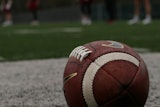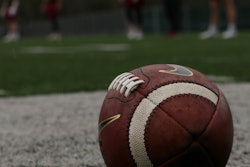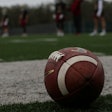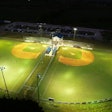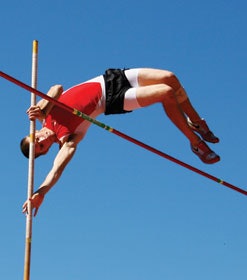
Duffy Mahoney didn't see the impact. Just hearing the dull thud of a 16-pound shot crushing a man's skull and the shrieks of witnesses was sickening enough.
Mahoney, one of USA Track & Field's foremost experts on meet management, was working the 2005 U.S. championships when 77-year-old Paul Suzuki, himself a 30-year officiating veteran, was fatally struck as he stood within the shot-put sector during practice. Imagine being hit in the head with the heaviest available bowling ball after it has been launched some 60 feet through the air - the full brunt of that force concentrated within a sphere measuring a mere 130 millimeters in diameter.
"I was watching the athletes in and around the circle as they were picking up their shots and warming up," Mahoney recalls. "This official was out in the field. An older gentleman, he was not fleet of foot and, in my judgment, had a lapse of awareness. He just turned and moved the wrong way at the wrong time."
The staging of field events, with their emphasis on the hurling of heavy implements and human bodies, poses risk management challenges unlike those in any other sport. Here, tight quarters and loose supervision can sometimes conspire to put the well-being of athletes, officials and non-participants in serious jeopardy.
Consider the catastrophic and near-catastrophic injuries that have occurred worldwide this decade in just the throwing events:
In April 2007, Lone Jack (Mo.) High School junior shot-putter Rebekah Whaley was on the Plattsburg High infield retrieving a practice throw when she was hit above the left ear by a three-pound discus. The blow opened a gash requiring 14 staples to close and caused the honor student's language and reading skills to temporarily regress to that of a third-grader. The following month, 73-year-old USATF Masters thrower Clarence Cook was hit in the head by an errant discus and later died from his injuries. Eyewitnesses told www.masterstrack.com that Cook was about 20 meters from the throwing circle and walking outside of and away from the left line of the throwing sector when he was struck.
Last April, a 16-year-old student at Adachi Higashi high school in Japan was picking up a hammer 40 meters from the throwing circle when he was knocked unconscious by an airborne one weighing more than 13 pounds. The student lapsed into a coma. In 2005, University of Southern California thrower Noah Bryant saw his sophomore season cut short when the 16-pound hammer he threw ricocheted off protective screening and into his face, which required reconstructive surgery. Bryant, who returned to an All-American career at USC, was fortunate that steel plates in his cheek represented the worst of his ordeal. According to the Los Angeles Times, hammer throws claimed the lives of four people in Europe in 2000 alone.
Still think such accidents are far-flung? A single track practice at South Sound Christian School in Kalama, Wash., in 2005 resulted in unrelated injuries to two students. One, a 12th-grader, was impaled through the chest by a javelin. Minutes later, a seventh-grade shot-putter ran out to retrieve his throw when a shot hit him in the head. Incredibly, both athletes survived. Despite their accidental nature, recent episodes like these have led to litigation (see "A Shot Put to the Head - A Potential Legal Headache," Nov. 19, 2008).
In its 25th annual report, released last year, the National Center for Catastrophic Sport Injury Research revealed that spring high school sports were associated with 118 direct catastrophic injuries from 1983 through 2007. Injury rates were less than one per 100,000 participants for each sport, but track and field led all sports with 59 total injuries. Moreover, that number paints a misleading picture of the risks posed specifically by field events, according to center director Fred Mueller. "The participation numbers are large in track and field," when running events are included, he says. "So if I have a pole vaulting injury or some kind of weight injury - discus or something - and then I use the total number of participants, that's going to bring the incidence rate per 100,000 way down."
Breaking down each field event in terms of participation is extremely difficult, says Mueller, adding that a number often cited for the pole vault, which has accounted for the majority of the nation's track and field injuries, is 25,000 participants. "If that's the number, then that incidence rate is going to be pretty darn high for just the pole vault," he says.
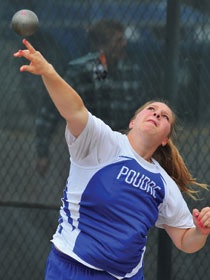
More than any other field event, the pole vault has come under intense safety scrutiny within the past half-dozen years. When 18-year-old Ryan Moberg died last April, days after falling backward onto the pole vault runway during a failed practice attempt at DeSales High School in Walla Walla, Wash., it marked the first pole vault fatality in the United States since 2002. The deaths of three vaulters within a two-month span that year led to the adoption in 2003 of sweeping rules changes at the high school and collegiate levels regarding the sizing of landing systems and the padding of all hard perimeter surfaces.
Yet, it still wasn't enough to guarantee the safety of Chase Kear. Last October, Kear, a 19-year-old sophomore at Hutchinson (Kan.) Community College, missed the pit on a vault attempt and landed on his head, causing a fracture that completely encircled his skull. Despite an emergency room prognosis that put Kear's chances of survival at less than 50 percent, he is now expected to make a full recovery, earning him the nickname "Miracle Man."
Of course, padding can only extend so far, as illustrated in the Moberg case. But whether mandated helmet use might have helped spare Moberg's life is only the latest talking point in a lengthy debate. High school pole vaulters in six states (Maine, Minnesota, New Mexico, North Dakota, South Carolina and Wisconsin) are required to wear helmets, yet pole vault experts contend that to adequately protect vaulters falling from even minimal heights would require helmet padding so thick that it would cross the line from essential protection to performance hindrance.
Beginning with the 2006-07 academic year, the actual poles used at high schools nationwide must be rated and labeled by manufacturers and verified by practice coaches and meet officials to match the weight of the user, helping to protect against breakage and promote greater user control while limiting institutional liability. According to Becky Oakes, assistant director of the National Federation of State High School Associations and editor of its track and field rules, pit and pole rule changes have "combined to significantly reduce the number of injuries in the pole vault - both catastrophic injuries and injuries in general."
The only safe bet for schools is to eliminate the event altogether, and some are choosing to do just that - though the attrition rate has not yet reached javelin and hammer-throw levels. Given that the typical pole costs more than $200 (an athlete who is gaining both expertise and weight may require several poles over the course of a single season) and that landing pits meeting or exceeding NFHS standards (a minimum 19 feet, 8 inches wide; 16 feet, 5 inches deep behind the vault box; and 26 inches thick) carry prices ranging between $8,000 and $18,000, decisions to cut pole vault are often driven as much by cost savings as risk management.
Even schools offering pole vault are finding that the rule changes have forced adjustments to the staging of meets, including moving that particular event outside the track oval. "The pad has gotten so big that there really isn't any room on a radius to keep the pad far enough away from the track and still give the runner enough runway to approach the pad," says certified track builder Sam Fisher of Fisher Tracks, the current president of the American Sports Builders Association's Track Division. "So they're putting the pole vault out behind the bleachers or someplace. The track purist wants everything in front of the bleachers. That can be done at a track-only venue, but land is getting too precious to build a designated track facility."
Likewise, throwing events are being held on adjacent practice fields, leaving the high, long and triple jumps alone on the track infield at some schools. There are two primary reasons for this, according to Fisher. "One is the proliferation of synthetic turfs, which won't take a shot being thrown on them, and the discus will actually skip on them," he says. "And obviously safety is a big factor. You have a whole bunch of kids out there for a track meet. All it takes is for somebody to space out a little bit and run across the throwing sector."
But alternative throwing locations can't guarantee safety, either. "Years ago, I saw sectors ... yeah, they were in the practice field, but you had to walk across the practice field to get to the restrooms," Fisher says. "You had a lot of people darting back and forth across there."
Fisher says the mere presence of portable bleachers at a throwing site can help clue in spectators as to where they should gather, but running flag lines to designate "free zones" remains standard procedure. Trouble can arise, though, when the lines are staked straight out and not parallel to the sector's pie shape. Says Oakes, "The farther out they go, they almost intersect the throwing sector line."
In the interest of uniformity and safety, the shot and discus sectors for high school throwers have, since 2007, matched the 34.92-degree sector size long shared by collegiate and international competitors - "the thought being," Fisher explains, " 'Let's teach them how to throw properly from the beginning and not get so wild out there.' " The NCAA, meanwhile, has recommended that the throwing sector be placed within a 55-degree free zone, ensuring that each foul line of the sector is sufficiently buffered for safety. "It's several feet, and the farther out you go the bigger it gets," says Mahoney. "It's not a requirement, but believe me, if it's a recommendation and it has to do with safety, it's going to be covered by a lawyer in a liability situation."
Manufacturers are doing their part - even going above and beyond the regulatory call, in some cases - to promote field event safety. Conversion kits consisting of peripheral padding flanges have helped bring schools with obsolete pole vault pits up to speed, even as mega-pits measuring 32 feet wide by 21½ feet deep have hit the market. Pits exist that offer nearly as much padding square footage on the runway side as they do behind the vault box, leaving a concave channel for the pole plant as the only immediate area of exposure. Sweet spots, denoted by a different color on the pit cover, not only give vaulters a target upon landing, but the foam underneath is engineered to better reduce the force of impact.
Throwing cages now feature curved metal supports that drape heavy-gauge netting away from potential ricochet points, and some employ a second layer of netting around the cage perimeter to keep onlookers at a safe distance from throws hitting the cage. Many cages include dual swinging gates at the opening, allowing adjustments to be made for left- and right-handed throwers. And cages, like pole vault pits, have gotten bigger - much bigger. "The hammer cage at the international and NCAA levels is now 10 meters tall. That's 33 feet. They're gigantic," Mahoney says. "To high-level high school kids who come to one of our championships and for the first time step into one of our cages, it looks like they're throwing out of a narrow canyon. They haven't practiced with it enough to understand the science of it - that the implement, if released, could not conceivably hit that gate if it's a legal throw."
Though high school, collegiate and international governing bodies do not require shot-put cages, manufacturers have recognized a safety void worth filling. And in an effort to relieve congestion in throwing sectors, one manufacturer debuted a shot-put return system at the 2007 Penn Relays, allowing officials to send shots back to the throwing circle by placing them on a metal ramp - not unlike the ball return in a bowling alley - providing a designated place for coaches and participants to retrieve their implements.
Whether these efforts significantly reduce catastrophic injuries across all field events remains to be seen. To this day, the pole vault carries with it a certain stigma, despite the great strides in safety made since the dark days of 2002. "The sport is under attack because of the injuries and deaths that we've had," Mahoney says. "And yet I can get up at a podium and speak a good case the other way, too. During two weeks in November, there were four deaths in marathons and half-marathons, and I don't hear anybody clamoring to cancel running events. Good officiating and good meet management is about approaching all possible liabilities and addressing them as effectively and safely as you can."
Ultimately, some of the safety onus must be placed on each of those individuals who find themselves inside a field event's danger zone. Throwers themselves should ensure a clear sector before executing a throw, though their backward (shot) or spinning (discus, hammer) starting positions can allow just enough time for intruders. Practice sessions can prove especially problematic. "Officials at sanctioned meets often do not regulate warm-up activities. Throwers who practice alone get habitual within their practice regimen," Dick Hotchkiss, former USATF Masters throws coordinator, told www.masterstrack.com. "Combine the two situations and the result can be disastrous."
One final piece of equipment to consider: the warning sign. "To reduce the risk of serious injury: STAY ALERT! FLYING OBJECTS!" reads one sign currently available for purchase.
When Mueller hears of injuries involving blows to the head from projectiles, he voices his own personal zero-tolerance policy. "Those things should never happen. If you run the meet right and kids know the safety rules, they should never be out there picking up their shot as another shot comes flying at them. I think those things could be totally eliminated."
The human element may ultimately prevent track and field administrators from reaching anything close to total injury elimination, but Oakes is hopeful that people working together on all fronts can help reduce the number of avoidable accidents in the field. The NFHS, for one, will host its first-ever Track and Field Professional Development Summit on Jan. 22 in Indianapolis, with USATF's Mahoney serving as its key presenter and risk management receiving priority focus.
"As with any athletic participation, there's always going to be an inherent risk of injury," Oakes says. "But I think that all rules organizations are trying to keep up with the rapid advancement in the performance and safety aspects of equipment. And in addition to that, the athletes, coaches and officials must keep up with the best practices in training and execution. All of us have to stay in the mix together - form a kind of a circle, if you will - to make sure that the events are safe."














